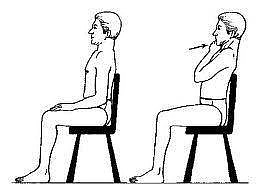- October 8, 2025
-
-
Loading

My partner in this month’s column once again is John Sutherland, P.T., who is the lead therapist and owner of White Sands Therapy and Aquatics in Sarasota.
The May “Aerobic Grandma” column was about forward head posture (FHP), also known as “chicken head,” a common postural abnormality. It can cause all kinds of problems, including pain in the neck and jaw, numbness in the upper extremities, stress or migraine headaches and reduced mobility of the head and neck. It is bad for your breathing and balance, and it makes a person look old and tired.
FHP comes from too much time spent looking down for whatever reason: occupation, reading, endless hours at the computer, even sleeping on your back with two pillows. Your head, which weighs about 11 pounds, is like a bowling ball balanced atop your neck between your shoulders. Your body is engineered to support it in a certain alignment of the spine, with the ear holes directly over the shoulders — what we call the “perfect perpendicular.”
For every inch that your head is forward of that, the bowling ball gets about 10 pounds heavier, forcing the muscles in your upper back and neck to work harder to keep your head up. The result is muscle imbalance: tightness in the upper trapezius, levator scapula, suboccipital, sternocleidomastoid (SCM) and pectoralis muscles and weakness of the deep neck flexors and lower scapular stabilizers, including the rhomboids and lower trapezius.
The good news is that there are simple exercises you can do to strengthen the weak muscles and stretch the tight ones.
Chin Retractions, aka the “Double Chin” move: Standing with your feet just inside of hip distance apart, interlace your fingers and position your hands just below your belt. Press your joined hands into your tummy, engaging your core and elongating your spine. Now inhale, stretching the crown of your head up towards the ceiling, lengthening your neck. Tuck your chin in, moving your ear holes back over your shoulders and hold five seconds. Take care not to tilt the chin up as you retract; keep it level and parallel to the floor. Exhale and release.
Repeat five times to start, working up to 10 reps. If your FHP is severe, the movement will be small to start, but you will gain range of motion as you progress.
You can do the same move seated in a chair or on the edge of your bed, feet planted firmly on the floor. Again, the caution is to keep the chin level.
You can also do it supine, a good way to start if your range of motion is limited and a nice thing to do when you get up in the morning. Lie on your back, knees bent. Place a small, thin pillow under your head (not a bed pillow). Close your ribcage to engage your core. Inhale, press the back of the head into the pillow and hold five seconds. You should be looking straight up at the ceiling, another way of saying do not tilt the chin upward. Release and repeat five times, working up to 10.
This move produces the look of its “double chin” nickname. Some sources suggest that you do it every hour. That may be unrealistic but retractions are easy to do standing in line or waiting for an appointment.
Chin Tucks: You can do the “double chin exercise” standing, seated or supine. Just pull your chin straight back; don’t let it tilt upwards.
The Doorway Stretch. FHP constricts the chest, further compromising posture and breathing. To stretch your pectoral (chest) muscles, you need a standard, 30-inch-width door. Stand in the doorway with weight on the primary foot and the other foot slightly behind you. Lift your bent arms to just below shoulder height so your forearms and palms are gently pressing into the doorjambs. Inhale and shift your weight forward so that your chest opens and your elbows move slightly behind you, keeping your head straight on your spine. Hold five seconds then shift your weight back to upright. Repeat five times, working up to 10. If you have happy shoulders, you can lift the arms slightly higher with each repetition to intensify the stretch as desired.
The Doorway Stretch. Note that weight is over forward foot, and elbows start below shoulder height and move up with repetitions.
Virtually all exercises that stretch and strengthen the head, neck and shoulders can be beneficial for FHP. If you have severe symptoms, see your doctor or visit a physical therapist for an evaluation. No referral is required, and the physical therapist will report to the physician of your choice.
The most important first step to stop looking like a chicken is to be constantly conscious of your posture. That awareness alone will help you stand tall, walk proud — and look younger.
BOILERPLATE
Molly Schechter is an ACE-certified personal trainer with a specialty in older adult fitness plus YogaFit Instructor Training, SCF Yoga Fundamentals I and II and Power Pilates™ Mat Certifications. She teaches classes at the Bayfront Park Recreation Center. E-mail her at mschechter@YourObserver.com.